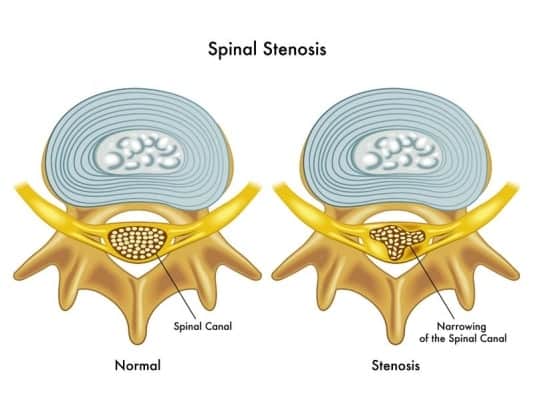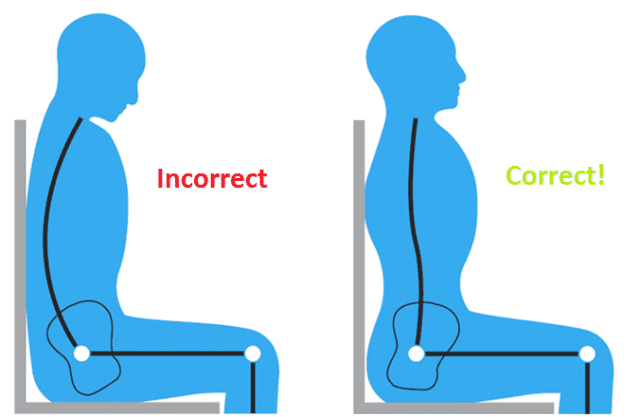Neural foraminal stenosis is a condition causing compression or narrowing of a spinal nerve while passing through the spinal canal via the foramen. The foramen is the opening between the vertebrae via which the spinal nerve travel and goes to other body parts.
It may occur in the lower back or the neck. It is caused due to a variety of reasons. Most of the time, it develops with the aging of the spine. For some people, it does not cause any symptoms and does not even require any treatment. However, for some, it may even cause paralysis.
Table of Contents
What Are The Symptoms Of Neural Foraminal Stenosis?
Most of us have some degree of neural foraminal stenosis. The symptoms are not shown until the foramina are still wide to allow the nerves travel via the openings. The symptoms start slowly and progress with time.
They may happen on one side or both the sides and also vary along with the part of the spine that narrows a nerve. However, when there is an absolute constriction in the foramina, the nerve tissues get stressed up and cause following symptoms:
- Pain in back or neck
- Numbness or muscle weakness of hands, foot, or leg
- A tingling sensation in the limbs
- Limited mobility due to difficulty while walking
- A burning sensation
Most of the times these symptoms affect one side of the body that constricts the nerves. Nevertheless, it is possible for them to occur on both sides too. This condition when the nerves are constricted from both sides is called bilateral foraminal stenosis.
The stenosis occurs in three different portions of the spine. When occurring in lower spine it’s termed as Lumbar foraminal stenosis. When occurring in the middle its termed as thoracic foraminal stenosis. And, when occurring in upper its termed as cervical foraminal stenosis.
The lumbar stenosis will develop symptoms in the lower back, hips, legs, and feet. The thoracic stenosis will develop symptoms in the upper back. The cervical stenosis will develop symptoms in the neck.
What Are The Causes Of Neural Foraminal Stenosis

The Neural Foraminal stenosis can occur due to regular wear and tear. However, the conditions progress with the age. The commonly occurring causes of neural foraminal stenosis are as follows:
1.Degenerative Spin Or Disc
A spine that is becoming constricted, narrowing the openings of the nerves with age. A degenerative disc is a point where the discs of the vertebrae degenerate and go out of place putting more pressure on the nerves that exit. A degeneration generally occurs in the lumbar region.
2.Herniated Disc
This condition is also referred as slip or prolapse disk. In this condition, one of the discs of the cartilage is damaged.
3.Spondylolisthesis
It is a condition in which a vertebra slides in the front or the back of the vertebra present below it. This one also occurs generally in the lumbar spine.
4.Osteoarthritis and Rheumatoid Arthritis
Both the condition occurs when the cartilages start degenerating because of age.
5.Osteophyte
This is a kind of bone spur. It’s an abnormal growth occurring in patients who are above 60 years of age.
6.Trauma
Reoccurring injury to the spine damages the vertebrae and may eventually result in the stenosis in any part of the spine. This happens to athletes and gymnastic individuals.
7.By Birth
Some individuals are born with a narrow spine so for them stenosis develops at an early age.
Diagnosis Of Neural Foraminal Stenosis
You will be asked about the symptoms and their occurrence time. A doctor will also do a physical examination and a radiological scan for the complete diagnosis. For this, a CT scan or an MRI scan is done to confirm the disease.
How It Is Treated
The treatment for neural foraminal stenosis majorly depends on the severity of the condition. For mild conditions, precautionary steps are taken. You may also be asked to take rest for few days so that the symptoms shouldn’t worsen over time.
For moderate symptoms, the doctor may take steps to cure the current the conditions and stop its progression too. You may be asked to perform exercises that improve the spinal strength and your overall fitness level.
Physical exercises will also strengthen the muscles, increase your mobility, stretch up your spine, and bring out a correct posture.
However, for cervical stenosis people are recommended to wear a cervical collar. Additionally, if your pain is unbearable the doctor may give you some medications like:
- Pain relievers like ibuprofen, naproxen, or acetaminophen
- Anti-seizure drugs that relief nerve pain. Some of them are pregabalin and gabapentin.
- Corticosteroid injections to decrement inflammation. Most of the people respond well to injections.
For severe cases, when the symptoms are not going on by exercise and medications a surgery may be recommended. Although, this happens in rare cases. The surgery is done to widen the neural foramen that is compressing the nerve.
For surgery, several factors are considered like the patient’s overall health status and the location of the problem in the spine. It’s a minimally invasive surgery that is done by the endoscopy technique. There are two surgical options for the same:
Interspinous distraction device: In this process, a device is implanted in the space between the vertebrae to increase the gap and relieve the pressure present on the nerves.
Foraminotomy: In this the bone that causes the compression is removed.
Home Remedies To Get Rid Of Neural Foraminal Stenosis
The natural methods aims to provide relief from symptoms rather than curing the condition. A number of therapies and home treatments have brought significant results in patients. They aim to slow down the degeneration and provide relief. Some of the best home remedies for neural foraminal stenosis are explained below:
1.Following An Anti-Inflammatory Diet

An anti-inflammatory diet has nutrients that reduce and heals up body inflammation from inside. Consume food that is rich in Omega-3 fatty acids like salmon, herring, walnuts, fish oil, etc. Additionally, consume natural healing food items like ginger, turmeric, nattokinase, papain, and serrapeptase. The diet slowly and gradually decrements the pain and inflammation from the body.
2.Maintaining Weight

Heavyweight people suffer from stenosis more as they find difficult to move. Maintaining weight would reduce the pressure on the compressed nerves and thereby relieve the symptoms. Although it alone cant does wonder, you have to follow a healthy lifestyle pattern and an exercise regimen along with it for best results.
3.Stretching

Stretching the spine relaxes the muscles, and removes stiffness from the spinal region. Perform stretching exercises daily. Concentrate on deep breathing while stretching. Some of the stretching exercises that help with stenosis are:
1.Sitting Leg Stretches
2.Stretch your knee till your chest when sitting on the floor
3.Lie down on your back lift your chest for a good back stretch
4.Pull one foot towards the buttock until you feel a stretch in the thigh. This is called a quadriceps stretch.
5.Perform hip and hip flexor stretches. For this, lie down on the floor and bend your legs. Cross one ankle over the knee and pull on the back of the thighs for a deep stretch.
4.Go for Physical Therapy

Physical therapies are done to increasing mobility, activity, and fasten the recovery process. A physical therapist will make you do exercises that strengthen the entire spine and core. They also have special machines that help to take pressure off the spine. They will guide to improve your posture and would also suggest you about medical aids like a mattress, pad, pillow, etc to relieve pain and discomfort.
5.Exercise

Health professional suggests exercising is the most desired way to relief and cure stenosis. It prevents pain and spinal compression to a much larger extent. However, you won’t see the result in a day or two but, a regular exercise regimen will surely give you long-lasting results.
A variety of aerobic activity and bodyweight exercises reduces the overall body inflammation and improves the strength of limbs and the core. Regular exercise will remove off the pressure from the spin and also reduce the risk of obesity or osteoporosis.
Regular full body workouts train the muscles of the core, thighs, back, and buttocks. It stabilizes the spine by pulling off the pressure and bringing closer the ligaments and joints together. However, you will see desirable results only when you are consistent. If you feel strong pain when exercising consult your doctor.
6.Stop Smoking

Smoking causes spinal discs to wear or degenerate faster. I know it won’t happen at once especially if you are a chain smoker. However, you can try cutting down the number slowly and gradually.
7.Maintain Posture

Maintaining proper posture when standing, sitting or exercising is a great way to protect the spine and reduce stress on the back. Don’t slouch your shoulders as it strains up the spine.
When sitting rest your back straight on a chair, heels on the floor and knees slightly bent. If you spend prolonged hours on a chair, try using support pillows or a support chair to maintain the proper postures.
Yoga Poses For Neural Foraminal Stenosis
Yoga is a powerful way of correcting postural alignment issues, increasing the flexibility, and strengthening the core muscles. As stenosis is more of a degenerative disease that impacts flexibility, the range of motions, yoga can aid in resolve all these issues and may even release tension in the spine. It does so by stretching out the spinal column and the pressure on the nerves.
Several studies have shown the effectiveness of yoga in treating the stenosis. However, always consult your doctor before doing the same. Some of the major yoga poses that should be carried out during recovery are mentioned below:
1.Bridge Pose
This pose is good for the lower back. It strengthens the lower back muscles by releasing tension from those muscles.
How To Do It?
- Lie down on your back with your knees bent.
- Lay down your arms straight on your sides on the floor.
- Your feet should be flat on the floor and lift your hip as much as you can.
- Raise your back slowly, don’t over exert. Exhale and come down slowly lowering your back to the floor.
2.Spinal Twists
This posture is good for stretching the hips and enhancing the core strength. But people with a ruptured disc or with spinal slippage should avoid it.
How To Do It?
- Lie down on the floor with your hands straight on the side.
- Twist your lower waist or body to one side.
- While twisting, don’t turn your neck or upper body. Stay in the position for few seconds. Repeat the exercise on the other side.
3.Child Pose
This pose is for the entire back. It stretches the hips, thighs, and ankles. It will reduce the stress and fatigue of the entire body. It’s a good pose to relax your entire back and the front muscles of the body.
How To Do It?
- Sit on your knees, your toes should be at the back facing outwards. Slowly and gradually bend down. Exhale and drape your torso in between your thighs.
- In this position, your heart and chest should rest on top of your thighs. Your hands should go back along your side.
- Try touching your forehead to the floor. Stay in the position for quite a few seconds. Slowly comes back.
4.Corpse Pose
This benefits the entire body. It calms the brain and relieves the stress and stiffness especially on the lower and the upper back. It is good for cervical stenosis as it relieves a headache.
How To Do It?
- Lie down on your back with your arms at your sides.
- Your palm should face up and your legs should be straight on the floor.
- Breath slowly and deeply in this position till your body relaxes fully. Be in this position for a minimum of three minutes.
5.Downward Facing Dog
This one elongates and releases tension from the entire spine. Additionally, it opens up the hips and shoulders. It is good for limbs, shoulders, and the entire body too.
How To Do It?
- Begin this pose by keeping aligning your wrist just under your shoulders and knees under the hips.
- Your wrist should be parallel to the floor or the mat. Stretch your elbows and relax the upper back.
- Press firmly via your palm and knuckles. Exhale as you tuck your toes. Slowly lift up your knees. Your body shape would resemble like a triangle.
6.Cow Face Arms
This is an effective exercise for cervical stenosis. It relaxes the entire neck area and the upper back too.
How To Do It?
- Kneel down raise your right arm towards the ceiling. Bend your right elbow and allow your right hand to fall between the shoulder blades.
- Take your left hand to the right elbow and the weight of the hand to deepen the openings of shoulders. Stay there for few seconds and then relax.
- Perform the same exercise for the other shoulder.
7.Shoulder Opener
This one is also a good exercise for cervical stenosis. It stretches the neck muscles and provides relief to neck pain.
How To Do It?
- Place the forearms on the wall parallel to one another. Keep them below your shoulder height and keep your elbows shoulder-distance apart.
- Move back from the wall and allow your head to relax between the hands.
- Stay in that position for few minutes and then come back to a normal pose.
Is Yoga Safe For Stenosis?
Yoga isn’t an answer for all the stenosis sufferers especially with people with chronic lower back pain. If you suffer from severe back and leg pain, you should be very slow with yoga poses.
For severe pain, try with slow stretching poses then slowly and gradually you can go with other asanas. Studies have shown effective results to people suffering from mild and severe pain.
However, for serious conditions like a herniated disc, severe spinal stenosis, spondylolisthesis, vertebral compression, etc yoga might not be a good option. Some of the yoga poses might worsen your condition.
Just to remain on a safer side always ask your doctor before starting with any yoga program. The doctor may advise you which program suit you and what level of activity is absolutely safe for you. Yoga, if done on a slow speed under an expert guidance, is always good.
FAQ’s
How Long Does This Last?
Neural Foraminal Stenosis can last from months to a year depending on the severity and treatment undertaken. Usually, a mild pain can last for few weeks to months if appropriate lifestyle changes and exercise regimen are followed.
For moderate pain, the treatment lasts for months. Most of times injections work wonders with the pain. An effective medical treatment and a healthy lifestyle pattern can certainly cure your condition to a much larger extent and in some cases, may even completely vanish it.
For the severe pain, when surgery is done the recovery period can last for quite a long time. In this condition, the pain is reduced to a great extent but most of the times complete cure is not seen.
What Are The Complications Associated With This?
Although, there are not many complications associated with the condition. Only very face some rare
complications that may last for the lifetime. A few of the complications associated with neural foraminal stenosis are as follows:
- Numbness in hand and legs.
- In chronic cases half body or full body paralysis.
- Urinary incontinence when you lose control over your bladder.
- Permanent weakness is when you feel difficult to perform your day-to-day task and your mobility is restricted to a larger extent.
When To See A Doctor?
You should see a doctor if you feel pain and numbness that goes down your arm or leg. The pain lasts is prolonged and lasting for more than a week. In such cases you should prefer for a medical help so as not to worsen your condition. However, immediate medical attention is needed in the cases mentioned below:
- A severe unbearable pain coming after an accident or injury.
- Pain in the arms or legs that is severe and sudden.
- Sudden inability to control your bowel and bladder.
- Paralysis of any body part.





